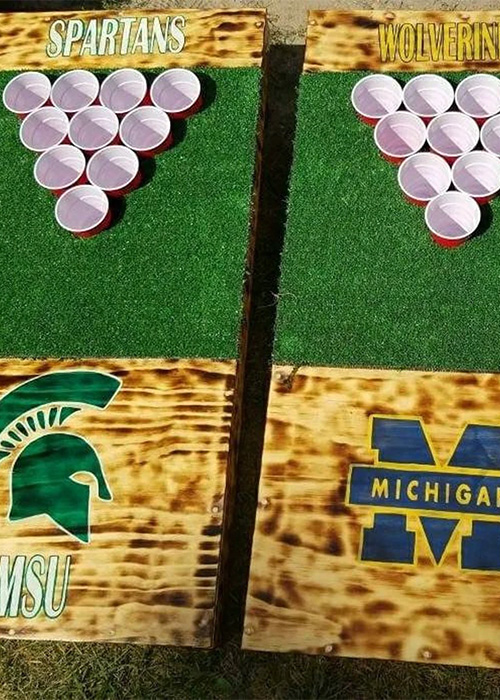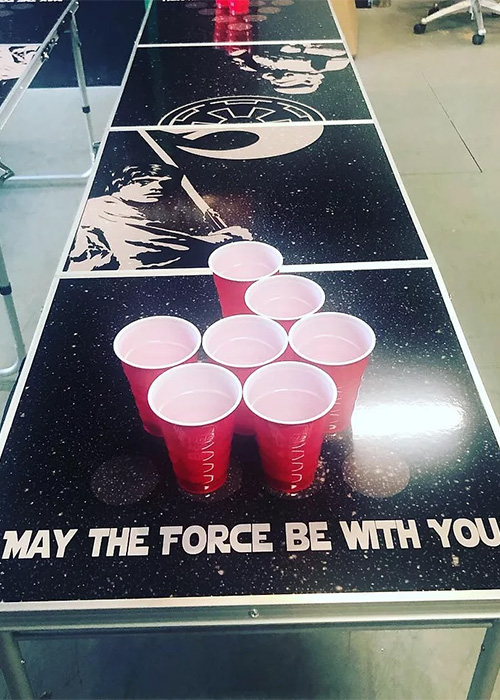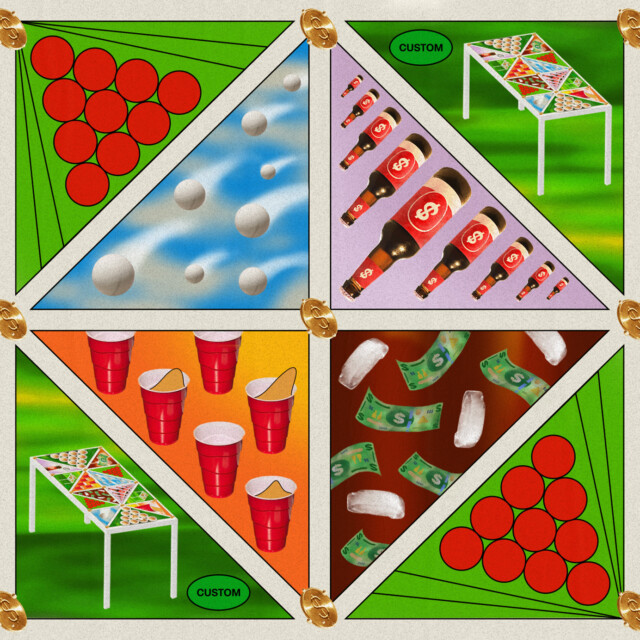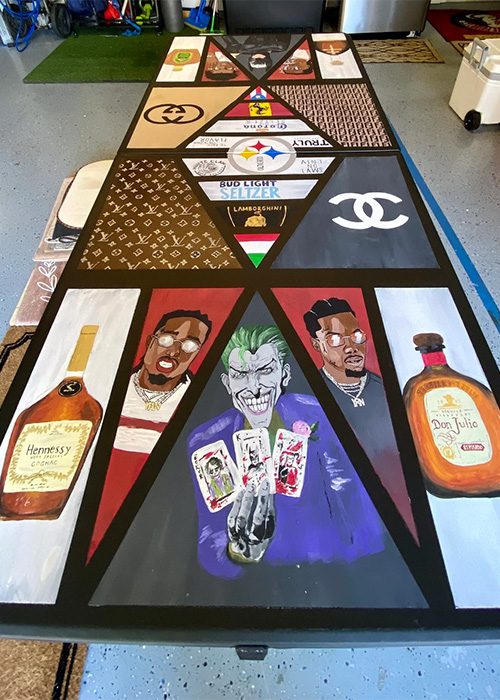Adam Wasserman had a problem. In 2007, he was working for a mortgage wholesaler when the side business he ran selling specialty furniture from his parents’ Los Angeles garage received a life-changing order. Out of nowhere, an agency in New York City had commissioned 120 tables — a massive windfall for the tiny firm. He scrambled to contract with a new plastics manufacturer that could produce the required volume of inputs. With just days to go before delivery, he took receipt of the materials and began the delicate finishing process, only to discover with horror that his graphic overlays wouldn’t cling to the thermoplastic polymer. “I knew nothing about manufacturing and plastics, and not nearly what I know today,” he recalls. With his passion project’s future hanging in the balance, he fired up a blowtorch and settled in for what turned out to be a pair of all-nighters spent melting vinyl decals onto injection-mold surfaces. It worked: They delivered the order. “Those are the times that you look back and just say, ‘Man, we can say we did all the bullshit needed to make your business grow,’” he says, laughing.
Wasserman’s entrepreneurial origin story is the stuff LinkedIn broetry is written about, which is ironic considering his business — PartyPongTables, maker of custom beer pong tables and other party paraphernalia — exists in a liminal space between professional strivers and party animals. But exist it has, for over 15 years. “We’ve been manufacturing tables and customizing them longer than anybody else out there,” he says proudly. PartyPongTables has survived the mortgage crisis (“I wasn’t personally responsible,” the co-founder assures VinePair), the Great Recession, and a decade and a half of changing tastes. When the pandemic hit, Wasserman feared it would finally do the company in; instead, sales quickly doubled. Everybody wanted a table of their own to pass the time during lockdowns.
The history of custom beer pong tables must be almost as old as the history of the drinking game itself, the roots of which stretch back to the mid-20th century basements of Dartmouth College and have come to feature all manner of regional offshoot and idiosyncrasy in the decades since. But while young drinkers have probably always decorated sheets of plywood with Sharpie’d signatures, Greek letters, team colors, and the like to enhance the competitive atmosphere and proclaim various allegiances, the advent of social media and online shopping in the aughts created a new, commercial opportunity.
In 2004, Facebook, with its school email address requirement, hit American campuses like a freight train, creating a central clearinghouse for party pictures and a massive, built-in audience to impress with ornately painted and personalized tables. Demand followed. In 2006, the same year that Wasserman and a since-departed co-founder were launching PartyPongTables at the University of Arizona, an entrepreneur named Billy Gaines introduced the World Series of Beer Pong with a tournament in Mesquite, Nev. His company, BPONG.com, would go on to sell over $100,000 in tables, cups, and assorted products (not to mention over half a million dollars worth of prizes to competitors.) As custom gear became a familiar fixture at tailgates and house parties, major media took note. “The game has been gaining fans on campus for more than a decade. But only in the past few years have entrepreneurs begun zeroing in on devotees who spend freely,” noted The Wall Street Journal in August 2007. “As beer-pong season hits a peak with the start of the school year, these beer-pong entrepreneurs are running tournaments and peddling customized beer-pong tables, balls and apparel.”
View this post on Instagram
That was 15 years ago almost to the day, and the world has changed incalculably since. Facebook is a cesspool overrun with confused boomers, democracy-threatening misinformation, and indecipherable viral chum. The millennials who took beer pong mainstream are now entering middle age. Hard seltzer changed the way college kids drink, then the pandemic changed the way everyone drinks. As undergrads head back to campuses for the 2022-2023 school year, VinePair spoke with four custom table makers from around the country to learn how this cottage industry has fared since the pandemic began — and what they think the future holds for the business end of beer pong.
***
The Semi-amateur Artist
It wouldn’t be accurate to say custom beer pong tables “jokerfied” Alexis Gordillo, per se, but it is definitely true that the Joker helped start her journey into selling custom beer pong tables. “The first one I did was a couple years ago, my cousin wanted one,” Gordillo says in a recent phone interview. Specifically, he wanted a table featuring portraits of Batman and his leering nemesis at either end, plus a half-dozen brand logos, flags, and patterns in between.
Gordillo, 20, is studying for a degree in biomedical sciences at the University of South Florida, and has no training as an artist, but decided to give it a go anyway. Using painter’s tape, she tessellated a plastic folding table into a latticework of triangular sections of varying size, then set about hand-painting designs in each.
(This layout, which vaguely resembles a stained-glass window frame, has become quite popular because of how easy it makes it to cram a bunch of different cultural references onto a single, standard six-foot folding table. You may recognize this minorly viral example from mid-pandemic.)
The first project, begun in 2018, was slow going. “That table took me quite a while,” recalls Gordillo. There was plenty of touch-up work: It was only later that she’d learn to lightly sand the tables’ polymer surfaces to prevent dried paint from peeling up with the tape at the reveal. “I literally wanted to cry because it’s like hours of painting [each] triangle,” she says. But finally, she delivered her cousin the table he’d envisioned. The response was encouraging. “Everyone started freaking out, like, ‘Oh my gosh, you’re so good at this. It’s so cool. You should really take this to a platform.’” she says. Thus, VarsityWaves — the name of Gordillo’s Etsy shop — was born. The operation is limited, given she’s a full-time student and does all the work herself in her parents’ living room. “My mom gets mad at me sometimes because I have paint all over the place.” But the money is solid, especially for a side hustle designed for enjoyment and to supplement the undergrad’s savings. Gordillo has sold between 10 and 15 custom tables for between $250 and $400 depending on the number of hand-painted triangular “tiles” a customer wants covering the surface of their table. (The tables and paint she sources from big box stores like Walmart and Michael’s.)
Who are those customers? “I actually don’t get a whole lot of frat orders,” clarifies Gordillo. “I think it’s because it’s Etsy. Not a lot of frat guys are scrolling through Etsy.” By contrast, VarsityWaves is popular with sorority sisters, says Gordillo, who is herself a member of Kappa Delta at USF. Demand for beer pong tables usually picks up in early November and peaks around the holidays, but the hand-painted Greek paraphernalia she makes are a hot ticket as summer turns to fall. “Greek paddles, that’s my big spike for back-to-school,” she says.

The Crafting Couple
It all started with a couple of crappy, costly cornhole boards. They were a gift Colbie Ray had gotten her husband, Bryan, and they didn’t even last a single camping trip. “You know the morning dew you get the next day [after] camping? My husband wiped them down and put them in the truck, and they were just completely warped,” she says. “So we made our own.” Bryan bought the lumber and figured out a schematic on his own (“he’s a jack of all trades”) and Colbie handled the design. Almost immediately, friends and family were asking for their own boards, and within a few months, they were asking for beer pong tables, too. Demand quickly overwhelmed them. “We started getting too many orders to be able to go to work” and also fulfill them, says Colbie. “We actually lived up in Michigan, and we knew we didn’t want to live there the rest of our lives and this business was taking off for us, so we just packed up all our stuff and moved to Tennessee.”
That was five years ago. Since then, the Rays, both 35, estimate they’ve made around 3,000 custom beer pong tables and cornhole boards, many of which they’ve sold via CustomOutdoorGames, their popular Etsy page. Colbie says they’re working on setting up a website, but demand is so strong without one thanks to word-of-mouth referrals and Etsy orders that it’s hard to keep up. “Currently, we’re getting probably around 50 orders a month,” she says. Like Gordillo, each CustomOutdoorGames table is hand-painted, but where VarsityGames uses pre-built folding tables with plastic slabs atop metal legs, the Rays build each unit from scratch out of wood. (In slow months, Bryan tries to work ahead by building blanks so Colbie has tables ready to paint as orders pick back up.)
The production cycle reflects the custom nature: “I would say a typical timeline is about two weeks, but right now it’s like four to six weeks, and it really depends on the [complexity of] the order,” Colbie tells VinePair. “My main sellers right now, for whatever reason, are [the University of] Alabama, Jack Daniel’s, and Beavis and Butthead. Those are three things that I can get done pretty quickly because I’ve done so many of them.” The Rays’ customers are often families or significant others buying gifts for the men in their lives. “I don’t hear a lot of ‘I’m getting this for my wife,’ for whatever reason,” she says.
The business used to be seasonal — Father’s Day and graduation create a reliable early summer influx of orders each year — but the pandemic has ramped everything up. “We’ve pretty much doubled once Covid started,” says Colbie. “During the summer months, a lot of people get tables for their kids that are going to college. Usually it will slow down a little bit in August and September, but we’ll see, because it’s been pretty steady. And then October through December is just crazy again.”
The Double-duty Designer
Connor Brown has no illusions about his own beer pong prowess. “I suck at it. Nobody wants to be my partner ever,” he tells VinePair, laughing.
After graduating from the College of Wooster in northeastern Ohio, Brown launched a sign-making and printing company in Latrobe, Pa., in 2017. He figured Moseye Graphics would mostly be engaged in the design and application of custom vinyl wraps for commercial vehicles. “I went to a training class and learned a bunch about different tools and everything,” Brown recalls. But when one of his buddies ordered a custom beer pong table that arrived with crappy, poorly designed graphics that peeled off the surface, he realized his expertise was transferable. “It just kind of clicked there.”
Moseye Graphics’ drinking game “division,” Moseye Pong, grew slowly at first. “I wasn’t doing too much to begin with,” recalls Brown, who designs and produces all the tables himself in a mini storage unit in Latrobe that houses his laser printer. In 2019, the only orders he received came in December, in the immediate run-up to the holiday season. The next year was pretty much the same. But in 2021, things started to pick up: Moseye Pong received around 45 orders in November alone. This year, “it’s been growing exponentially. … July started to do really well out of nowhere, August started to do really well out of nowhere, so I’m hoping it continues in that trend,” Brown says. Not that he did anything differently: He’s never advertised, and is “terrible” with social media. Table sales have all come courtesy of his shop’s five-star ranking on Etsy, or word-of-mouth.
At VinePair’s request, Brown puts some rough numbers to the custom beer pong table business model. In 2022, the company has sold around 10 tables a month, each at $250. His margin on the tables is roughly 75 percent. He sources blank aluminum folding tables directly from a supplier to avoid Amazon’s higher unit prices and shipping delays, uses the same eco-friendly, soy-based inks that he uses for his other sign work, and already owns the printer and design software. It’s a good revenue stream, and Brown says he plans to ride the beer pong table wave for as long as it lasts — within reason. “There are definitely opportunities for actually making decent sales and probably end up taking more profits,” he says. “But I have a boy that’s turning 1 next month. And I get a lot more time with my family. So that’s great.”

The Longtime Veteran
PartyPongTables’ Adam Wasserman has been selling custom beer tables and other party gear since he was 24, and he’s amassed the frustrations to show for it.
“People in this country, they do not want to manufacture,” he says, the exasperation evident in his voice. “Not only that: I can’t even get the materials! There are, like, one or two major aluminum extrusion companies [in the country.] They laugh when they look at me trying to get product made, because I’m not General Motors. I don’t order enough.” Beer pong has long since become a fact of drinking life in this country, and PartyPongTables may sell more volume than its Etsy brethren, but custom tables are still a fundamentally niche product. So today, Wasserman sources anodized aluminum tables from suppliers in Asia and finishes them at his workshop in Southern California. In addition to plastering the surface with whatever design customers so desire, the company will — for a price — trick out the table’s edges with LED lights, and bore cup-size holes in the shape of a triangular rack at each end so your Solos don’t go sliding across its beer-slicked surface.
Wasserman has had several partners at PartyPongTables over the years, including his younger brother at one point. But it didn’t last: “He didn’t have the passion that I had. I mean I founded this and built it from absolute scratch.” These days, the business is just Wasserman and two employees; in addition to the aluminum tables, they also sell wooden ones, plus cornhole boards, portable bars, and Hexcups, which are basically Solo cups optimized for beer pong via interlocking rims that sit flush against each other. Wasserman acquired the intellectual property for the vessel’s design from a group of engineers in Missouri who’d designed them. “They were like, ‘We know nothing about business, plus we’re full-time engineers, we have jobs,’” he explains.
For now, beer pong remains Wasserman’s full-time job. At 40, with two kids, he’s still working on deals with retailers and hustling new angles to keep the party going. Earlier this summer, he emailed Post Malone’s agent in hopes of pitching the rapper on becoming “the Jordan of the beer pong industry.” It’s a business, but it’s also a lifestyle. “I love knowing that our products are allowing people to have a really great time, including myself,” he says, in response to whether he plans to hang it up any time soon. “I hope that just because we are getting older doesn’t mean we’re gonna stop partying.”

